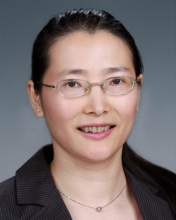MSE 298 Seminar: Understanding and Controlling Crystal Growth and Structure-Function Relationship of Nanomaterials via in situ TEM Techniques

Senior Materials Scientist
Physical Sciences Division
Pacific Northwest National Laboratory
Abstract: Nanomaterial properties such as morphology, size, strain, defect, etc. are tied to their structures at micro-, nano- and atomic scales. Understanding the fundamental mechanisms of crystal growth, formation of heterogeneous structures, and factors that control them enables us to design materials with tailored properties. In this work, we study mechanisms of crystal growth via particle assembly (a common pathway) and formation of heterogeneous structures by integrating in-situ techniques, such as Transmission Electron Microscopy (TEM) and Atomic Force Microscopy (AFM), with theoretical simulations. During particle assembly processes, interactions between active species at liquid-solid interfaces can help to establish conditions to control the assembly process and crystal structures. We study the crystal surface interactions as a function of viscosity, pH, electrolyte type and concentration and the resulting structures and defects formed via particle aggregations. In addition, deformations of structures (meta-stable phases) at the atomic scale, especially long-range ones, can significantly enhance their functional behavior, such as catalytic activity. We discover a new physical picture of transitional structures, in which continuous variations in atomic positions form from one phase to another. These gradient structures give rise to continuous band bending, resulting in high photoactivity. The results of this work enable us to control crystal growth and the resulting structures and design materials with tailored properties.
Bio: Dongsheng Li is a senior materials scientist in the Physical Sciences Division at Pacific Northwest National Laboratory. Before joining PNNL, Li was a scientist at Lawrence Berkeley National Laboratory and a postdoctoral fellow at UC Riverside. She holds a Ph.D. in materials science and engineering from Pennsylvania State University, University Park. Her research focuses on crystal nucleation and growth, materials synthesis and processing and structure-function relationships. She partners with the U.S. Department of Energy to explore crystal growth mechanisms via non-classical growth pathways to form branched nanowires. Specifically, using in situ Transmission Electron Microscopy (TEM) and Atomic Force Microscopy (AFM), her group has made many discoveries on particle-mediated growth, especially Oriented Attachment (OA) processes, solid-state phase transformation processes and the resulting structure-function relationships. Li’s significant understanding of the kinetics and dynamics of OA processes in the iron oxyhydroxide system gives insight into further understanding and control of crystal growths via OA and resulting structures and properties. Li has given multiple special invited lectures at physics and materials conferences.
Share
Related Content
| Attachment | Size |
|---|---|
| 1.03 MB | |
| 671.5 KB |
Upcoming Events
-
MSE 298 Seminar: Conquering Thermalization
-
CBE Seminar: Creating a New Circular Carbon Economy via Carbon Capture, Utilization and Storage
-
CEE Seminar: Digital Rock Physics: Applications in Fluid Flow and Rock Deformation
-
MSE 298 Seminar: Exploring Light and Life: Nanophotonics and AI for Scalable Molecular Sensing, Sequencing, and Synthesis
-
Homecoming 2025
